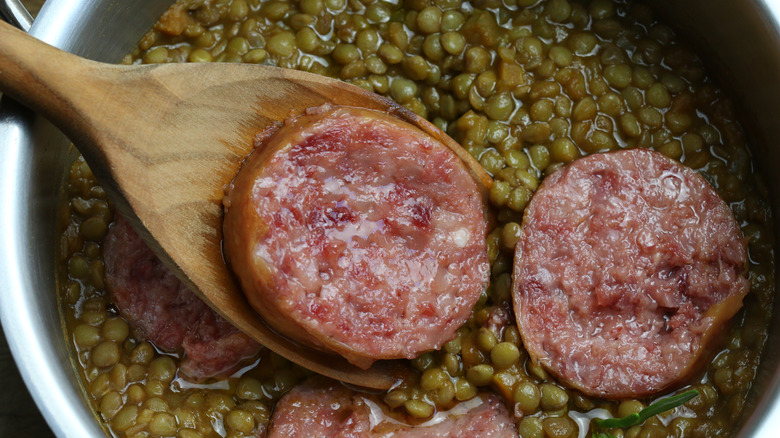The Traditional Italian Sausage That's Eaten On New Year's Eve
As New Year's begins to inch its way closer, billions of people will join in on the festivities at the stroke of midnight all over the world. Perhaps you've already thought of ways to glam up your New Year's Eve party like stocking your pantry with bottles of bubbly champagne or sparkling wine. One popular way to celebrate the new year, as is true for most holidays, is by enjoying a hearty meal together. Depending on where you're spending the holiday, that could mean rolling out a time-honored culinary tradition or dishing out certain foods that are meant to symbolically bring good luck and health in the year to come.
If you find yourself in Italy on New Year's Eve, don't be surprised when a plate of sliced pork sausage and lentils arrives at your table. Italy is famous for having one of the best cuisines in the world. For New Year's, people opt for a classic dish known as cotechino con lenticchie. Its name comes from the word "cotica", which refers to the pork rinds in the sausage filling. The round, flat shape of cooked lentils and their yellow color are reminiscent of coins. Some Italians may recall stories of their parents stuffing their pockets with lentils for good luck. In Europe, eating pork is also thought to bring good fortune. With all these good tidings, this unique Italian food is said to rake in one's wealth and happiness throughout the following year.
How Italian cotechino sausage and lentils became a holiday dish
Cotechino is a sausage consisting of pork, lard, pork rinds, and various spices. Its creators originally introduced cotechino in Modena with origins tracing back to an almanac note from 1745 before its recipe began appearing in cookbooks filled with Italian food recipes. Initially, people created cotechino to use less desirable parts of their pigs as they would slaughter pigs in December. This led cotechino and lentils to become a traditional staple on Christmas and New Year's. Its birthplace was once the subject of dispute but the dish now has its own officially recognized certification that protects its cultural roots in Modena.
As the years passed, new ways to make cotechino sausages came to light. With new spices and pig breeds, the sausages slowly became more palatable to a wider audience. Leaner rinds and tastier fillings became part of the sausage casings. Additionally, people began aging the sausages for a few weeks before boiling, slicing, and serving them over lentils. These days, many variations of cotechino and lentils exist. Some might add their favorite type of white wine to the lentils as they cook. Meanwhile, some regions will even give their pork mixture a dash of vanilla during the curing process.
Cotechino and lentils is leagues better when it's made by hand
If you're ever presented the opportunity to enjoy authentic cotechino, this type of sausage is often best if it's made by hand for its rich, juicy flavors. Mass-produced pork sausages will likely have an off-putting texture and be disappointingly void of flavor. The difference again proves that homemade food made with love is generally the superior choice, especially when enjoying culturally significant meals like this.
Although this Italian New Year's dish often comes with crusty bread to mop up the sauce, cotechino also pairs well with soups, crumbled over fried polenta, or used as a ragout with risottos or pasta dishes. A fluffy batch of buttery mashed potatoes is a popular side dish for cotechino and many recipes for the lentils call for a mixture of carrots, onions, garlic, and bay leaves. If your goal is to respect tradition, enjoy it with lentils and raise a glass of bubbly to usher in the New Year along with the good luck that comes with it.


